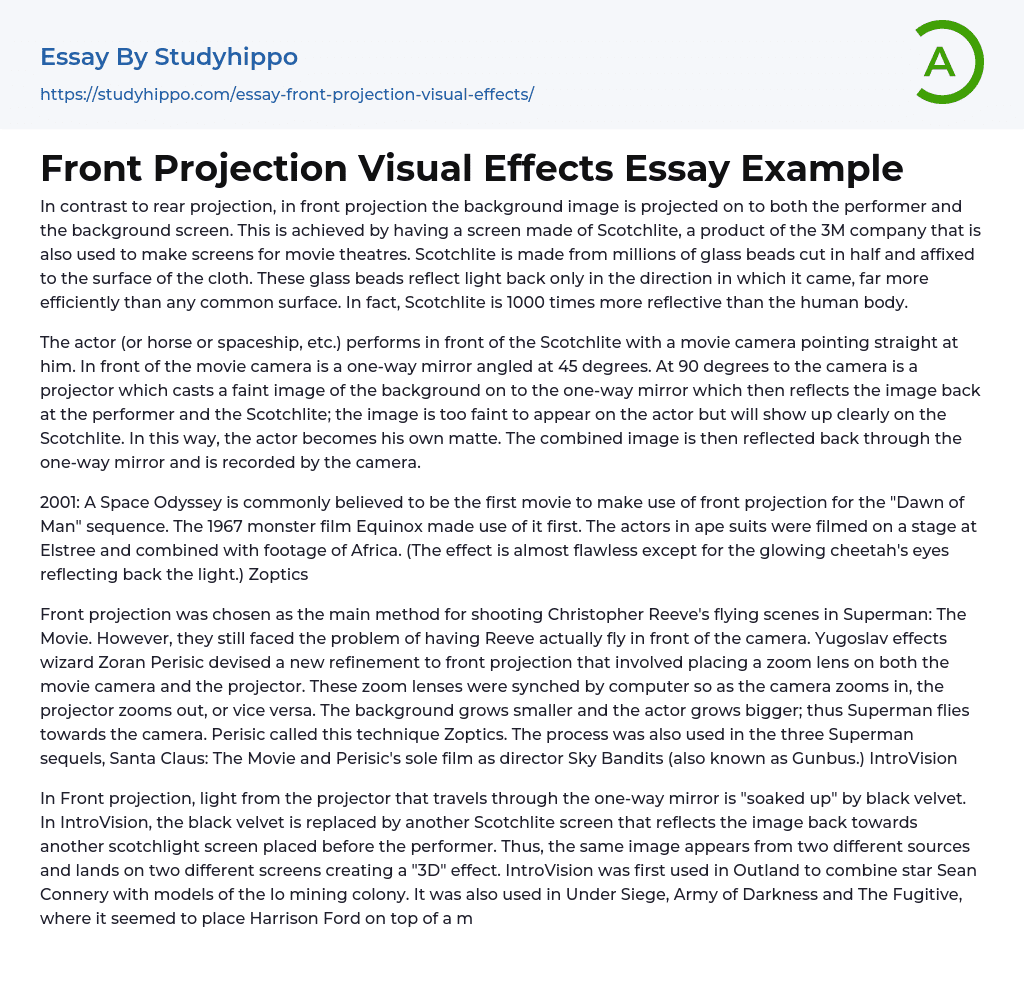Unlike rear projection, front projection projects the background image onto both the actor and the backdrop. This is made possible by using a Scotchlite screen, a product from 3M Company that is also utilized in making screens for cinemas. Scotchlite comprises millions of halved glass beads attached to fabric. These beads reflect light back in the same direction it came from, making it vastly more efficient than any other regular surface. Remarkably, Scotchlite's reflectivity is 1000 times greater than that of the human body.
An actor, horse, spaceship or the like, performs in front of a Scotchlite, with a film camera directly facing them. A semi-transparent mirror is placed at 45 degrees in front of this camera. The projection system, at a 90-degree angle from the camera, projects a dim background image onto this mirror which then reflects back at both
...the Scotchlite and the performer. The projection is intentionally made dim so it does not display on the performer, but distinctly visible on the Scotchlite. Thus, the actor is essentially transformed into their own matte. This blended image subsequently bounces back through the one-way mirror to be captured by the camera.
The film 2001: A Space Odyssey is often mistakenly credited as the pioneer in the use of front projection for the "Dawn of Man" segment. This technique was originally employed in the 1967 creature feature Equinox. Actors clad in ape costumes were shot on an Elstree stage and amalgamated with footage from Africa, resulting in an exceptionally realistic outcome, aside from glowing cheetah eyes reflecting light. For Superman: The Movie, Zoptics Front projection was selected as the primary filming mechanic for Christopher Reeve's flying sequences
However, filming Reeve flying close to the camera posed a challenge. Zoran Perisic, a special effects expert from Yugoslavia refined front projection by installing a zoom lens on the projector and motion picture camera. The lenses were synchronized with a computer such that when the camera zoomed in, the projector would zoom out, and vice versa. This resulted in Superman appearing to fly closer to the camera. Perisic dubbed this Zoptics. This technique was subsequently utilized for three Superman sequels, Santa Claus: The Movie, and Sky Bandits (also known as Gunbus), directed by Perisic himself. IntroVision, where black velvet (which absorbs light from the projector) is replaced with another Scotchlite screen that reflects towards another scotchlight screen placed in front acter, is another modification in Front projection.
The identical image can be observed from separate sources and is featured on two different display panels, producing a "3D" impact. IntroVision was first applied in the movie Outland and allowed the merging of the lead actor, Sean Connery, with models portraying the Io mining town. The technology was similarly employed in Under Siege, Army of Darkness, and The Fugitive. It gave a convincing illusion of Harrison Ford being perched atop a miniature bus that is then struck by a toy train. Front projection, now a dated technology, had various benefits over its chief competitor - bluescreen. It eliminated the presence of bold black outlines typically visible in bluescreen shot movies. It was not as time demanding and hence, less costly in comparison to the lengthy procedure of optically splitting and fusing foreground and background images using an optical printer. It enabled directors to visually inspect the background and
suggest necessary modifications ("Jump now, Harrison!"). Primarily with Zoptics, it also offered a more adaptable system that could facilitate complex sequences which were challenging to undertake using bluescreen during that time. However, with progress in digital compositing techniques, front projection has become redundant. The last considerable blockbuster that utilized front projection significantly was Sylvester Stallone's action-drama Cliffhanger.
- The Pursuit Of Happiness essays
- Incandescent Light Bulb essays
- 12 Angry Men essays
- A beautiful mind essays
- A Separation essays
- Alfred Hitchcock essays
- American Beauty essays
- American Films essays
- Animation essays
- Avatar essays
- Blade Runner essays
- Bollywood essays
- Bond essays
- Bridge essays
- Cinema Of The United States essays
- Comedies essays
- David essays
- Dead Poets Society essays
- Do The Right Thing essays
- Documentary essays
- English-Language Films essays
- Erin Brockovich essays
- Film Analysis essays
- Film Editing essays
- Film Noir essays
- Film Techniques essays
- Finding Forrester essays
- Forrest Gump essays
- Gattaca essays
- Gladiator essays
- Glory essays
- Good Will Hunting essays
- Hamilton essays
- Hollywood essays
- Horror essays
- Jaws essays
- King kong essays
- Like Water For Chocolate essays
- Looking For Alibrandi essays
- Martin Scorsese essays
- Melodrama essays
- Monster essays
- Moulin rouge essays
- Movie Analysis essays
- Movie Review essays
- On The Waterfront essays
- One Flew Over The Cuckoo'S Nest essays
- Our day out essays
- Pearl Harbor (Movie) essays
- Persepolis essays




